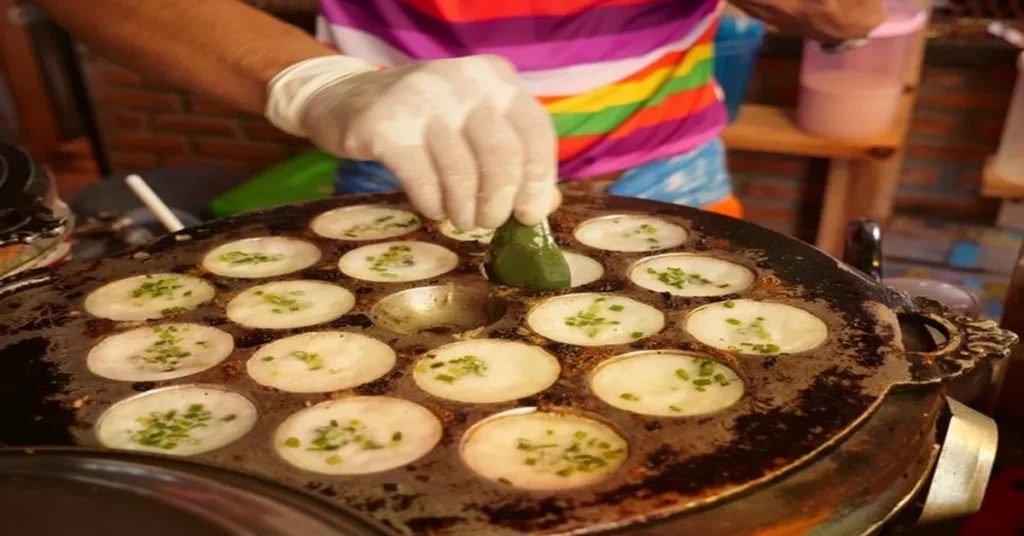Festivals are a time of joy, connection, and celebration. They weave together stories from our past and give us the opportunity to create new memories with loved ones. Each festival carries its own unique customs, rituals, and flavors that reflect the rich tapestry of culture we belong to. One such delightful tradition is the preparation of homemade bappam, a sweet rice cake that tantalizes both taste buds and hearts alike.
Bappam holds more than just culinary significance; it symbolizes community spirit and continuity. As families gather in kitchens filled with laughter and chatter, they share not only recipes but also tales passed down through generations. The process of making bappam transforms into an art form—an expression of love influenced by age-old practices.
With every bite of this fluffy delicacy during festive occasions, you can savor not just flavor but also heritage. Join us as we explore the cultural significance behind festivals celebrated with homemade bappam while igniting your passion for keeping traditions alive in your kitchen!
A Taste of Tradition: Celebrating Festivals with Homemade Bappam
Homemade bappam is more than just a dish; it’s a symbol of tradition, warmth, and community. During festivals, this delicacy takes center stage at many celebrations. Families come together to prepare bappam, sharing stories that have been passed down for generations.
The process starts with simple ingredients: rice flour, coconut milk, and sugar. Each family has its own secret touch that adds character to the dish. Some may add a hint of cardamom or sprinkle in some grated coconut for extra texture. The smell wafting through the kitchen as it cooks evokes nostalgia and anticipation.
Making bappam often becomes a communal activity where everyone pitches in—children measure ingredients while elders guide them through techniques they’ve mastered over years. This practice fosters connections across generations and reinforces family bonds during festive gatherings.
As families gather around steaming plates of bappam after hours spent preparing it lovingly together, there’s an unspoken understanding of what this moment means—a celebration not only of food but also of heritage. Each fluffy bite carries flavors that tell stories from times gone by.
Different regions celebrate unique festivals with their variations on bappam too. For instance, during Onam or Vishu in Kerala, you might find banana leaf platters adorned with vibrant dishes alongside homemade bappams showcasing local flavors.
Moreover, these festivals allow people to share their creations beyond familial boundaries—offering homemade bappams to neighbors strengthens community ties while inviting others into shared cultural experiences centered around food.
This beautiful exchange highlights how traditions evolve yet remain rooted in love and connection fostered by something as simple yet profound as cooking together during special occasions.
Read: Creative Recipes Using Guajes: Elevate Your Meals with This Versatile Ingredient
Introduction: The Cultural Significance of Festivals
Festivals are vibrant celebrations that reflect the rich tapestry of culture and tradition. They bring communities together, fostering a sense of belonging. Each festival is an opportunity to honor heritage, spirituality, and history.
These events often revolve around agricultural cycles, religious observances, or seasonal changes. They serve as reminders of our roots and the values that bind us. Festivals are not just about merrymaking; they also convey deep cultural narratives.
Food plays a central role in these gatherings. It acts as a medium through which traditions are passed down generations. Special dishes like bappam hold significant meaning during festivals, symbolizing love and community spirit.
Celebrating with homemade delicacies enhances the festive experience. Cooking traditional recipes evokes nostalgia while creating new memories with family and friends. The act of preparing food together fosters unity among participants.
In many cultures, each dish has its own story tied to folklore or religious significance. These culinary tales enrich festivals further by connecting people to their ancestors’ experiences and beliefs.
Moreover, festivals provide a platform for artistic expression—through music, dance, and storytelling alongside shared meals like bappam. This combination elevates communal joy while nurturing creativity within communities.
The essence of festivals transcends mere celebration; they encapsulate identity and continuity in society’s ever-changing landscape.
The Art of Making Homemade Bappam
Making homemade bappam is an art that combines tradition with culinary skill. This fluffy, steamed rice cake holds a special place in many festival celebrations. The process begins with selecting high-quality ingredients to ensure the best taste and texture.
The primary ingredient for bappam is rice flour, which gives it that unique softness. Some families prefer using freshly ground rice for added authenticity. Alongside this, coconut milk adds richness and flavor, elevating the dish to new heights.
To achieve the perfect consistency, water is gradually mixed into the rice flour until a smooth batter forms. This step requires patience; too much water can result in soggy cakes while too little may lead to dryness. Finding balance here is key.
Fermentation plays a crucial role in making bappam light and airy. Many people allow their batter to sit overnight at room temperature. As yeast develops naturally from the environment, bubbles form within the mixture—this contributes significantly to its delightful fluffiness.
Cooking methods vary by region but steaming remains popular for authentic results. Using banana leaves as liners not only imparts a subtle aroma but also prevents sticking during cooking.
Once cooked, homemade bappam takes on an enticing fragrance that fills your kitchen with warmth and nostalgia. It’s often served alongside savory dishes or sweet toppings like jaggery syrup or grated coconut.
Each bite of this traditional delicacy transports you back through generations of family gatherings and celebrations where food serves as both sustenance and symbol—a true testament to cultural heritage passed down lovingly through time.
Traditional Festivals and the Role of Homemade Bappam
Festivals are a time for joy, celebration, and connection. They bring families and communities together, creating lasting memories rooted in shared traditions. In many cultures, food plays a central role during these festivities. Among the myriad of dishes enjoyed, homemade bappam stands out as a true symbol of heritage.
Bappam is more than just a treat; it embodies the spirit of communal sharing. During traditional festivals, families often gather to prepare this delightful dish. The process itself becomes an event—a chance to bond over mixing ingredients and steaming the batter together.
The distinct flavor and texture of homemade bappam make it an essential part of celebrations such as Eid or Christmas in certain cultures. It’s served warm with coconut toppings or sweetened with jaggery—each bite telling stories passed down through generations.
In addition to its delicious taste, bappam serves as a reminder of cultural identity. Many people associate this dish with their childhood experiences during festival times when family members came together in the kitchen filled with laughter and love.
Each region may have its unique twist on making bappam, showcasing local ingredients and cooking techniques. This diversity enriches not only the culinary experience but also reinforces community ties during festivals.
Homemade bappam evokes nostalgia among those who grew up enjoying it at various events throughout their lives. Its presence at festive gatherings encourages younger generations to engage in traditional cooking practices while preserving recipes that define their cultural history.
As families share stories around tables laden with homemade delights like bappam during these special occasions, they reinforce bonds that contribute significantly to both individual identities and collective heritage within communities.
Read: Hailey Welch Net Worth Journey: Success, Struggles & Strategies
Preserving Heritage Through Homemade Bappam
Homemade bappam is more than a delightful treat; it embodies the essence of cultural heritage. This traditional delicacy has been passed down through generations, serving as a bridge connecting the past with the present.
In many communities, making bappam is an integral part of family traditions. The process often involves gathering loved ones to share recipes and techniques that have stood the test of time. Each family may have its unique twist, but they all value preserving this culinary art.
The ingredients used in homemade bappam reflect local sourcing practices and seasonal availability. Families often rely on age-old methods for fermenting rice and using natural sweeteners like jaggery or coconut sugar. This not only keeps tradition alive but also supports sustainable farming practices by promoting locally grown produce.
Festivals provide a perfect backdrop for these celebrations of culture. During special occasions, families come together to prepare large batches of bappam, filling homes with enticing aromas that evoke nostalgia. These gatherings are about more than just food; they’re moments where stories are shared and memories are created.
By engaging in the act of making homemade bappam during festivals, individuals actively participate in their cultural narrative. They keep beloved customs alive while teaching younger generations about their roots and values associated with these rituals.
Social media platforms now serve as modern storytelling avenues where families can showcase their unique takes on this dish. Photos and videos highlight not only the final product but also the processes involved—enhancing community ties around shared experiences linked to heritage cooking.
Thus, each bite of homemade bappam represents a rich tapestry woven from history, love, and communal spirit—all essential components in preserving cultural identity for years to come.
Conclusion: Embracing Tradition Through Homemade Bappam
Homemade bappam holds a special place in the hearts of many. Its rich flavors and unique texture make it more than just food; it is a symbol of heritage and community. Each bite tells a story, connecting generations through shared memories.
As families gather during festivals, the act of making bappam becomes a cherished ritual. It fosters togetherness as ingredients are measured, mixed, and cooked with love. This process transforms an ordinary moment into something extraordinary.
The recipe for bappam varies from household to household. Some add coconut or jaggery for sweetness, while others opt for spices that give it depth. These variations reflect personal touches passed down through time.
Making homemade bappam also encourages mindfulness about our culinary traditions. In an age dominated by convenience foods, taking the time to prepare this dish reminds us of our roots. It invites us to appreciate the art behind cooking.
Festivals provide the perfect backdrop to serve homemade bappam. Its presence at celebrations enhances not only meals but also relationships among loved ones who gather around the table sharing stories and laughter.
By choosing to create this traditional dish at home, we contribute to keeping cultural practices alive. We celebrate not just occasions but also the values they embody—love, unity, and respect for one’s heritage.
Embracing tradition through homemade bappam enriches lives in multiple ways—it tantalizes taste buds while nourishing connections between people across ages and backgrounds.
FAQs
Bappam is more than just a dish; it’s a symbol of tradition and culture, especially during festive seasons. By making homemade bappam, families not only celebrate their heritage but also create lasting memories in the kitchen. This beloved delicacy brings people together, allowing them to share stories while indulging in its unique flavors.
Here are some frequently asked questions about bappam:
1. What is Bappam?
Bappam is a traditional rice cake popular in various cultures, often made during festivals and special occasions. Its soft texture and slightly sweet taste make it a delightful treat.
2. Can I use different ingredients for Bappam?
Yes! While the classic recipe includes rice flour and coconut milk, you can experiment with additional flavors like pandan or spices to suit your palate.
3. How long does Homemade Bappam last?
Homemade bappam typically lasts for 2-3 days when stored in an airtight container at room temperature. For longer storage, consider refrigeration or freezing.
4. Is there a vegan version of Bappam?
Absolutely! Most traditional recipes naturally fit into a vegan diet since they primarily consist of plant-based ingredients like rice flour and coconut milk.
5. What festivals are most commonly associated with Homemade Bappam?
Festivals such as Onam, Eid al-Fitr, and Christmas often feature homemade bappams as part of celebratory meals due to their cultural significance.
Embracing tradition through food creates connections across generations. Each bite of homemade bappam tells a story—a story worth sharing every festival season.







